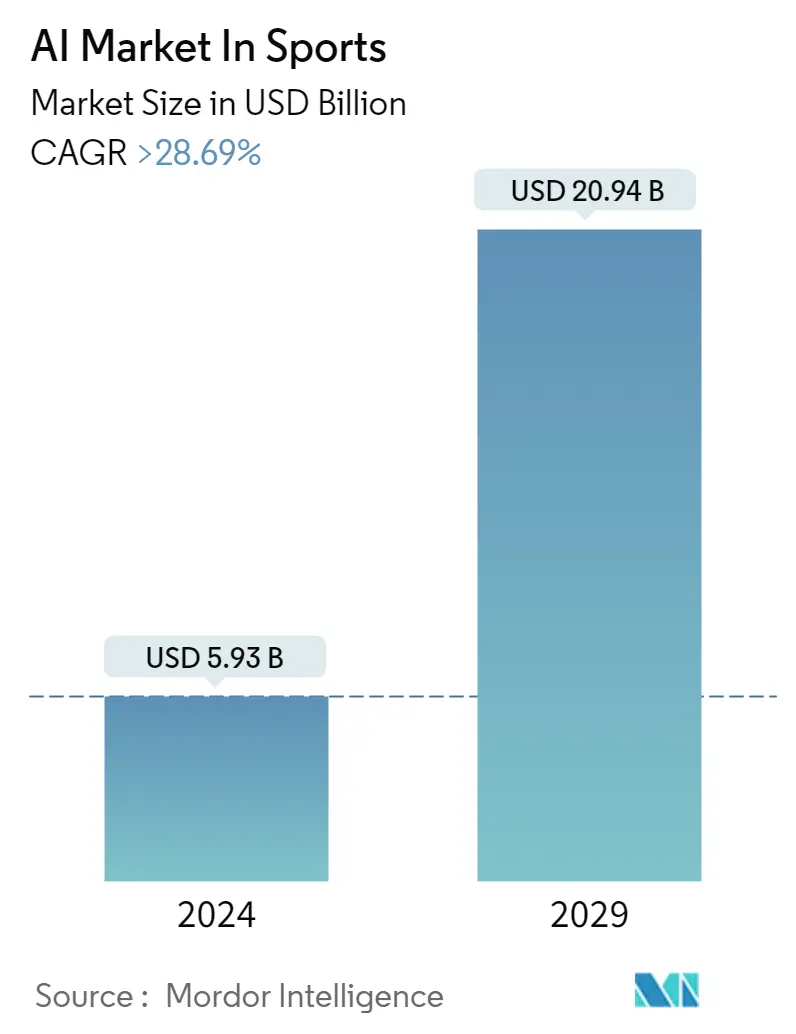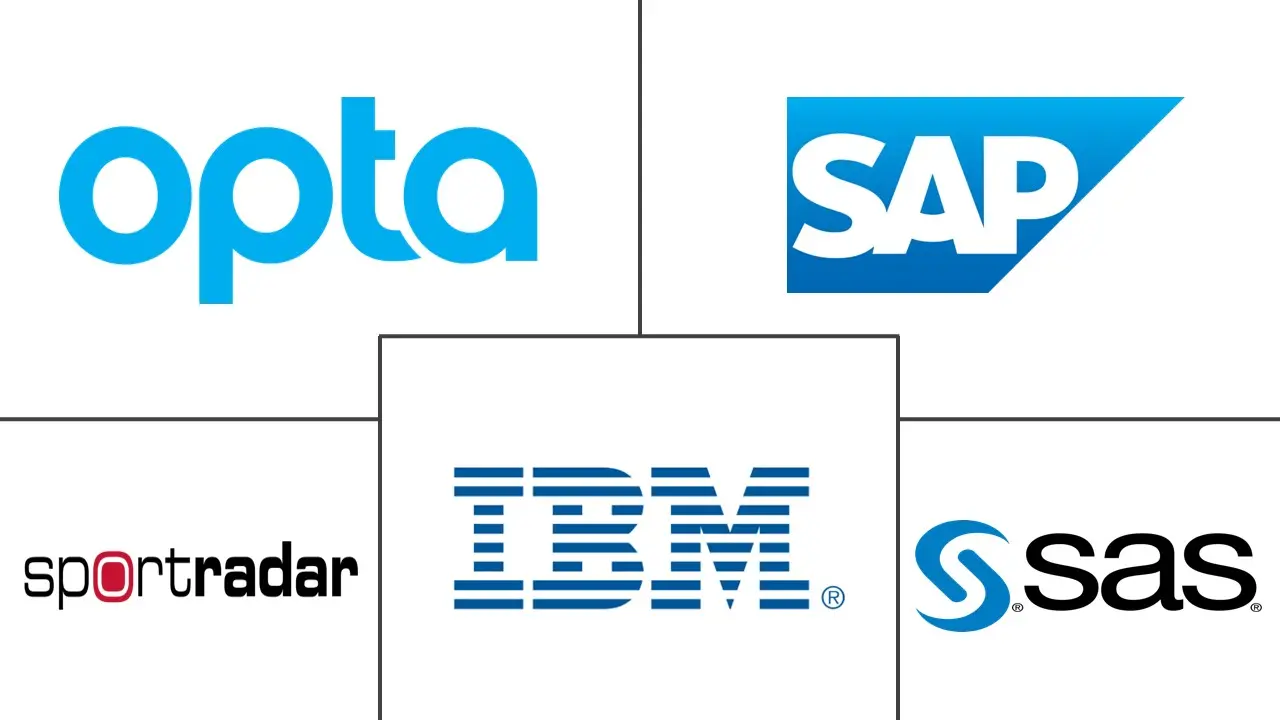Market Size of AI Industry In Sports

| Study Period | 2019 - 2029 |
| Market Size (2024) | USD 5.93 Billion |
| Market Size (2029) | USD 20.94 Billion |
| CAGR (2024 - 2029) | 28.69 % |
| Fastest Growing Market | Asia Pacific |
| Largest Market | North America |
Major Players
*Disclaimer: Major Players sorted in no particular order |
Artificial Intelligence (AI) in Sports Market Analysis
The AI Market In Sports Industry is expected to grow from USD 5.93 billion in 2024 to USD 20.94 billion by 2029, at a CAGR of greater than 28.69% during the forecast period (2024-2029).
The growth of the market is driven by the increasing use of technology in sports, particularly in well-developed sports. As the prices of these services decrease due to economies of scale, they are expected to be utilized in university and junior levels of various sports. Furthermore, as technology evolves every year, its applications are expected to widen.
- The volume of on-field and off-field data generated by various sports organizations has increased, leading to the need for managing and analyzing the data. As a result, the number of wearable devices in the sports industry has increased to meet the growing demand for monitoring and tracking player data. These devices generate detailed data on player performance and fitness variables such as heartbeat, speed, and acceleration.
- In November 2023, Loughborough University and Signify Group, one of the global leaders in leveraging AI to combat online abuse and threat, announced a collaboration that would see them collaborate on academic research into online abuse in sports. Signify has a proven track record in the sector, conducting high-profile projects with leading organizations in international football, tennis, cricket, esports, rugby, basketball, and athletics organizations.
- Artificial intelligence is used to analyze the data and engage fans. Real-time insights generated through data analysis during match time help teams make changes to their strategies. The growth of worldwide artificial intelligence in the sports market is driven by the desire for virtual assistants and chatbots to communicate with fans, as well as the increasing demand for player monitoring and tracking data.
- The expansion of the market is also fueled by the rise in demand for real-time data analytics. However, it is limited by the shortage of qualified and competent personnel, as well as the high installation and maintenance costs. Nonetheless, the increasing demand for AI in generating future predictions is expected to create lucrative opportunities for market advancement during the projected period.
Artificial Intelligence (AI) in Sports Industry Segmentation
Artificial Intelligence is a part of computer science deployed to mimic human functions like reading, answering, and recognizing images or voices of things to transform or improve decision-making based on data received from other sources. Artificial intelligence in sports is being employed to track player performance and help improve the health of the player through suggestions on injury - but now AI and machine learning are being used in sports enterprise applications to enhance sports planning.
The artificial intelligence market in sports is segmented into application (player analysis, fan engagement, data interpretation & analysis, and other applications), deployment (on-premises and cloud), and geography (North America, Europe, Asia Pacific, Latin America, and Middle East and Africa). The report offers market forecasts and size in value (USD) for all the above segments.
| By Application | |
| Player Analysis | |
| Fan Engagement | |
| Data Interpretation & Analysis | |
| Other Applications |
| By Deployment | |
| On-Premises | |
| Cloud |
| Geography | |
| North America | |
| Europe | |
| Asia Pacific | |
| Rest of The World |
AI Market In Sports Size Summary
The AI in Sports market is poised for significant expansion, driven by the increasing integration of technology within well-established sports frameworks. As the cost of AI services decreases due to economies of scale, their adoption is expected to extend beyond professional levels to include university and junior sports. The burgeoning volume of data generated both on and off the field necessitates advanced data management and analysis solutions, leading to a rise in the use of wearable devices that monitor player performance metrics. These advancements are further supported by collaborations, such as the one between Loughborough University and Signify Group, which focus on leveraging AI for various applications, including combating online abuse in sports. The market's growth is also fueled by the demand for real-time data analytics and the increasing use of AI to enhance fan engagement through virtual assistants and chatbots.
In North America, the vibrant domestic league system and substantial investments in sports have positioned the region as a leader in the AI sports market. The integration of AI is transforming both pre-game and in-game strategies, with companies like Argo Ai and Ford collaborating with NASCAR to enhance safety measures. The market is characterized by a few dominant players, but the proliferation of technology is expected to attract new entrants. Recent developments include partnerships and innovations aimed at utilizing AI for various purposes, such as transforming fantasy football data into insights and enhancing sports betting analytics. These advancements highlight the growing importance of AI in sports, offering new opportunities for market growth and development.
AI Market In Sports Market Size - Table of Contents
-
1. MARKET DYNAMICS
-
1.1 Market Overview
-
1.2 Market Drivers
-
1.2.1 Growing Demand for Real Time Data Analytics
-
1.2.2 Demand for Predictive Insights To Enhance Fan Engagement
-
1.2.3 Increasing Engagement of Fans in Sports
-
-
1.3 Market Restraints
-
1.3.1 High Initial Investments Required to Implement Complete Solutions
-
-
1.4 Industry Value Chain Analysis
-
1.5 Industry Attractiveness - Porter's Five Forces Analysis
-
1.5.1 Threat of New Entrants
-
1.5.2 Bargaining Power of Buyers/Consumers
-
1.5.3 Bargaining Power of Suppliers
-
1.5.4 Threat of Substitute Products
-
1.5.5 Intensity of Competitive Rivalry
-
-
-
2. MARKET SEGMENTATION
-
2.1 By Application
-
2.1.1 Player Analysis
-
2.1.2 Fan Engagement
-
2.1.3 Data Interpretation & Analysis
-
2.1.4 Other Applications
-
-
2.2 By Deployment
-
2.2.1 On-Premises
-
2.2.2 Cloud
-
-
2.3 Geography
-
2.3.1 North America
-
2.3.2 Europe
-
2.3.3 Asia Pacific
-
2.3.4 Rest of The World
-
-
AI Market In Sports Market Size FAQs
How big is the AI Market In Sports Industry?
The AI Market In Sports Industry size is expected to reach USD 5.93 billion in 2024 and grow at a CAGR of greater than 28.69% to reach USD 20.94 billion by 2029.
What is the current AI Market In Sports Industry size?
In 2024, the AI Market In Sports Industry size is expected to reach USD 5.93 billion.

